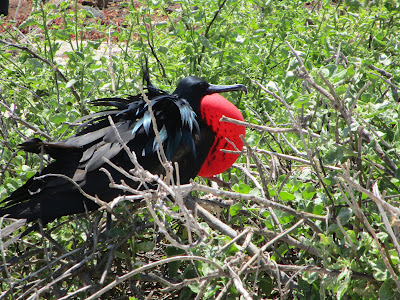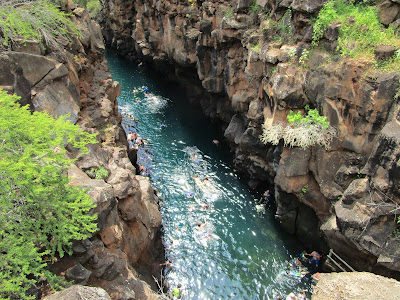For a small country, Ecuador is home to a remarkable diversity of environments and species. From the Amazon basin in the east, to the Andes and across to the coast, Ecuador seems to have it all. The Galápagos Islands, of course, make it a slam dunk. It is estimated that 10% of all plant and 1/6th of all bird species on earth are found in Ecuador.
I enjoyed my trek from the Andes to the Amazon in Peru, but Galápagos was my #1 reason for visiting this country. We booked ten days in Puerto Ayora, figuring we would arrange activities from here.
This is usually the cheaper way to do things (e.g., I booked my Salkantay Trek with two days’ notice in Cuzco, rather than via a Western company from abroad). Most people who arrive in the Galápagos explore it by cruise, and we hadn’t entirely ruled that out. Even the Lonely Planet guides, which normally don’t even mention cruises (they’re not exactly “shoestring” travel), will tell you that you can only scratch the surface of the Galápagos Islands without taking one. You can book a cruise last minute, and we checked into it, but the prices were still ridiculous. I mean given the amount of money it takes just to get here, and the fact that you can do day trips and various things independently.
This was certainly the right decision for our budget, and I can’t compare cruises because we haven’t been on one here. But if you’re taking the dream trip of a lifetime to Galápagos, I bet you’d still be better off booking a cruise—if you can afford it. I’m saying that partly because a cruise is usually the nicest way of enjoying any part of the world (if you can afford it!) But there’s no escaping the fact that what makes the Galápagos special is that each island is unique in its flora and fauna. A cruise is just going to take you to more different islands.
 T’s review of this part of our travels would be, ah, different. But I’ll give you the absolute highlight of my Galápagos, and possibly of the year. No, it wasn’t the beach nearest town (called Playa de los Alemanes or “German Beach”). That was a short water taxi ride away and not very impressive, although one of the nesting iguanas was comfortable enough to run right over T’s foot as if she wasn’t even there. I am talking about getting off Santa Cruz and to other islands: Seymour Norte or “North Seymour” and Mosquera; and Santa Fe.
T’s review of this part of our travels would be, ah, different. But I’ll give you the absolute highlight of my Galápagos, and possibly of the year. No, it wasn’t the beach nearest town (called Playa de los Alemanes or “German Beach”). That was a short water taxi ride away and not very impressive, although one of the nesting iguanas was comfortable enough to run right over T’s foot as if she wasn’t even there. I am talking about getting off Santa Cruz and to other islands: Seymour Norte or “North Seymour” and Mosquera; and Santa Fe.
There are only certain places in the Galápagos that people are allowed to visit, and on the uninhabited islands, this must be with a naturalist guide. Ours, the day we went to Seymour Norte, was very knowledgeable, especially about the birds that nest in colonies on that particular island. This time of year was nesting season for frigate birds, and they were everywhere.
I even saw one couple building a nest. Evidently the female birds are better food gatherers, so Dad mostly sits on the nest.
I’m not a bird watcher, but this was an incredible environment. The first bird we saw was actually a swallow-tailed gull, sitting on its egg.
The one bird I really wanted to see, though, was not in mating season, so we were lucky to see just one. This is the famous blue-footed booby. You may have seen a David Attenborough film where the booby, in mating season, lifts his blue feet one after the other in what, to a female booby, must be a very dignified dance.
Then we took the boat and made a “wet landing” at Mosquera, a pristine beach where sea lions just sit there, waiting to greet visitors. The sand here is coral that parrotfish have chewed up and excreted. All I know is it’s the hardest sand ever to get out of your swimsuit. It was worth it, though, because for an hour, I got to snorkel with sea lions! Not to take anything away from the gorgeous colours and schools of fish, but there were sea lions everywhere. And unlike dolphins, they really were swimming with us. At one point, six or seven were swimming around me, definitely outnumbering the snorkelers. They would swim right up to my mask, then veer away at the last second. One was a small sea lion, maybe shadowing its parent. They were so close it seemed certain that they were going to touch us (forget about the 2-meter rule), but they never did.
 |
| Mosquera |
“Beyond epic,” was how a young man in our group described it. To be fair, everything seemed to wow him—all the flags on my backpack. But about snorkeling with sea lions, he was right.
 Another place you can go in Puerto Ayora is La Ninfas Lagoon, a short walk down a street at the end of town. It’s a peaceful place to sit on the boardwalk, particularly if no one in the area is hammering and sawing. I saw fish jumping, an iguana swimming (used to that by now), and a brown pelican perched so determinedly on the hand rail that there was no way I could pass it and stay 2 m away.
Another place you can go in Puerto Ayora is La Ninfas Lagoon, a short walk down a street at the end of town. It’s a peaceful place to sit on the boardwalk, particularly if no one in the area is hammering and sawing. I saw fish jumping, an iguana swimming (used to that by now), and a brown pelican perched so determinedly on the hand rail that there was no way I could pass it and stay 2 m away.
We might have overestimated the amount of time we could spend on Isla Santa Cruz. None of these places are enough to fill a whole day, but they’re fun. I went to Las Grietas one morning, which are grottoes full of brackish water, “cold” by Ecuadorian standards. It felt good to me after walking from German Beach in the hot sun—I was soaked!
I was glad I got there when I did, because later in the morning, groups started arriving and it was full of screaming kids. While I was swimming, the water was so clear that I could see straight down to the bottom, and all the fish. In between swims, I walked a path to look out on Academy Bay, and for a while I had it to myself, bench and all. Quite a contrast.
Unfortunately, by the time of the day trips T. had started feeling poorly again. I waited until the last day to see if she was up for leaving the island again, but ended up joining a small group to Isla Santa Fe at the last minute.
It was amazing. We saw turtles from the boat. We snorkeled for an hour and saw a pair of rays mating, a couple small sharks, plus tons and tons of fish. Then we went to another place to snorkel and were joined by sea lions again. In between, we saw a family of sea lions on shore, including a baby learning to waddle along the rocks, and a whole colony of blue-footed boobies.
One of the boobies actually approached me in the sea, probing towards me with its beak! I could not get over putting my mask in the water and seeing its blue feet paddling away. Meanwhile the sea lions kept swimming by, then diving deep beyond us.
Later we had a ceviche lunch and a bumpy ride back to Hidden Beach, which is on Santa Cruz but can only be reached by boat. It was nice to walk around there, but nothing as spectacular as Tortuga Bay. I was glad at least T. and I had a good day together there, snorkeling and watching from the beach.
If you do travel to Galápagos independently, one thing I would recommend is to bring your own mask and snorkel (fins are not as important). If you don’t have them already, you can buy them on the islands and leave them at your guesthouse when you’re finished, or pass them on to another snorkeler. It will cost less than if you rented them each place, and you’ll be lucky to do so. I found that although the beaches, grottoes, etc. were said to rent snorkeling equipment, when I actually got there the place was likely to be closed, or nonexistent, or to run out of stuff. Of course, a day trip that involves snorkeling should include masks and snorkels, and fins as well.
One other small recommendation is to bring any books you may want to have with you, as English language (or any) reading material is hard to find on the islands, and very expensive! I saw one book for $40, and as for newspapers or magazines, forget it.
You don’t have to base yourself in Puerto Ayora, as we did. You could spend a few nights there and then take a ferry to the next inhabited island, and so on. I would definitely recommend staying on the inhabited islands, rather than trying to do them in a day trip. You’d spend too much of your day on a speedboat getting between them. Having said that, the best parts of my trip were visiting the uninhabited islands.
 |
| The closest we got to the flightless cormorant |
Sure, on more outlying islands you might see red iguanas or even a red-footed booby. You could see more than we did in ten days in Galápagos. But we’ve been here, and seen things I’m not sure I ever expected to see. And that’s pretty special too.
 |
| Photo courtesy of T. |











2 comments:
Delightful reading, Jacqui! We were struck by the frigate bird blowing a red bubble-gum bubble the size of Darwin's head--we didn't even know they chewed gum! And, having seen the Attenborough film, we shared your pleasure in seeing the blue-footed booby. Trish's photo thereof is brilliant! Finally, the exhilaration of snorkeling with sea lions at Mosquera was palpable, as they "played chicken" by swimming right at you and then veering away. P & G
The blog is really worthful to read. Thanks for sharing this beautiful blog about Galapagos tour. I always love to read the travel blog. The Galapagos Islands are a great place to take children for vacation and also they can get to learn a lot about nature from this incredible national park as well as appreciate the importance these islands have in the world today. There are many beautiful islands where you may check this to know about other islands: http://tiptopcruises.com/galapagos/
Post a Comment